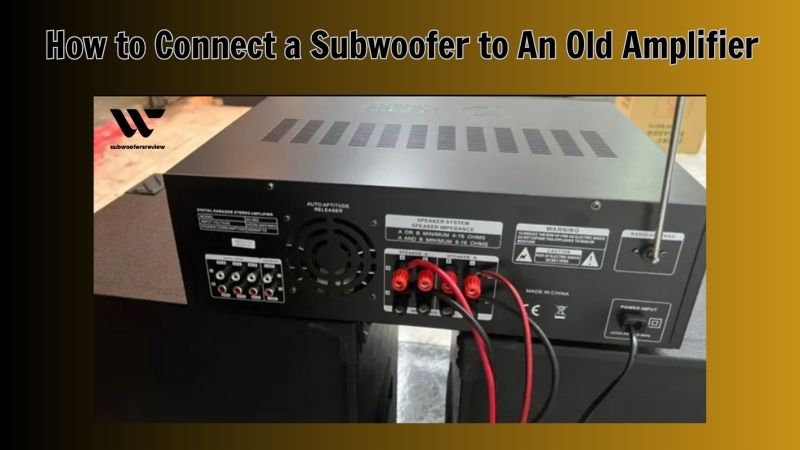Have you have what it takes to advance your audio experience? If you’re looking to enhance the bass in your sound system, connecting a subwoofer to an old amplifier might be just what you need. In this blog, subwoofersreview will explore the step-by-step process of how to connect a subwoofer to an old amplifier. So, let’s dive in and discover the secrets to achieving powerful and immersive low-frequency sound in your home setup!
What is the Difference Between New and Old Amplifiers?
An audio electrolytic capacitor is a cutting-edge feature included in the newest amplifier models. Compared to prior amps, this technology helps produce bass that is more accurate and lifelike. The difference between the noise levels produced by the antique rectifier and the vintage amplifier is minimal.
The updated power supply and more modern components are the new versions’ greatest advantages. They may generate a clearer sound with almost no distortion or vacuum because to these advantages. Along with improved performance, the new versions are also smaller and more streamlined in appearance. Over time, they shrink and use less energy.

How to Connect a Subwoofer to An Old Amplifier
Prepare tools
In order to use your old amplifier properly, you must first acquire the appropriate subwoofer. Finding an old amplifier is the next thing you must do. An amplifier that has a good reputation and is reliable can be purchased used. As a result, you won’t need to be concerned about your subwoofer or another object blowing a fuse.
You’ll need to purchase some extra speaker wire because the majority of the speaker wires that are included with the amplifier aren’t suitable for subwoofers. In order to connect the subwoofer and amplifier, you’ll need a wire that is long enough to reach between them, as well as wire nuts.
An outlet is the next thing you’ll need. The amplifier may be turned on and off without unplugging any plugs with the use of a gadget that can be plugged into subwoofers and amplifiers. Since the majority of subwoofers use this kind of connection, it is imperative that you select speakers with a standard socket.
A few tools will be necessary in the end. A utility knife, a drill, and a pair of scissors are required. In order to cut your speaker cable, you’ll also need a cord cutter.
Remove the Old Amplifier’s Faceplate
The old amplifier’s mask must be removed as a preliminary step. Using a screwdriver, carefully pry the piece out to accomplish this.
Disconnecting the speaker cord is the next step. The wire used to connect the subwoofer to the amplifier’s output is this one. It must be unplugged from the amplifier’s power output, which is typically found on the amplifier’s faceplate.
The speaker cable should be cut in half using a utility knife once it has been unplugged. You can manually push the two speaker wire halves together to form a single segment if you’re using brand-new speaker wire.

How to Connect a Subwoofer to An Old Amplifier
The audio connections that your old amplifier has available should be identified. Useable connections include RCA or speaker wire. Inputs for speaker level should be checked on your subwoofer. The amplified signal from the amplifier’s speaker output can be directly inserted into these inputs.
The speaker output of the amplifier should be connected to the subwoofer’s speaker-level input using a speaker wire if your subwoofer has one. Verify that you are accurately aligning the positive and negative terminals.
If your amplifier has RCA outputs or preamp outputs and your subwoofer only has line level (RCA) inputs, you can connect the two devices with an RCA cable. Connect the RCA cable’s one end to the RCA output of the amplifier or preamp, and the other end to the subwoofer’s line-level input.
You can utilize a line level converter in the event that your amplifier does not have an RCA output. In order to connect a subwoofer, this gadget converts speaker level impulses into line level signals. Use an RCA cable to link the line-level converter’s input to the subwoofer’s line-level input and the amplifier’s speaker output to the converter’s output.
Configure the subwoofer’s crossover frequency. When the subwoofer begins to play and the main speaker is turned off, this is controlled by the crossover frequency. Find the ideal balance between your main speakers and subwoofer by experimenting with various crossover settings.
To harmonize with the rest of your sound system, adjust the subwoofer’s volume. If your amplifier has a subwoofer controller, you can use that to do this, or you may do it directly on the subwoofer.
Put on some music and check out the subwoofer’s output. Double check all connections and settings if you experience audio issues or if the sound is not balanced with the main speaker.
It’s crucial to remember that getting the ideal results when using a subwoofer with an older amplifier without a dedicated subwoofer output may require some trial and error. There’s a chance that performance and control won’t be as accurate as with newer amplifiers made with subwoofer integration in mind. However, you may still enjoy improved low-frequency performance and add depth to your audio experience with the appropriate connections and settings.
Conclusion
In conclusion, connecting a subwoofer to an old amplifier is both feasible and beneficial for enhancing your audio experience. By following the simple steps outlined in this guide, you can ensure a seamless integration between your subwoofer and amplifier, allowing you to enjoy a fuller, richer sound. Remember to check the compatibility of your equipment, use the appropriate cables, and adjust the settings accordingly. With a little patience and effort, you can bring new life to your old amplifier and take your audio system to the next level.

